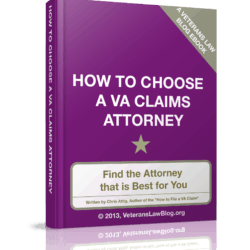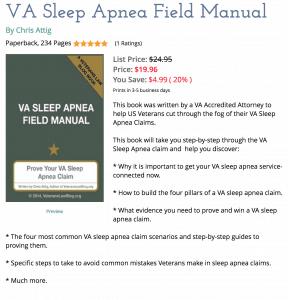I used to love flying in helicopters…twisting and turning at nap-of-earth level (right above the treetops, basically), the pulsing rhythm of the chopper blades…it always got my blood pumping.
What always struck me about riding in helicopters was the view – or more the perspective really.
The obstacles that appeared so challenging from the ground always seemed so…well….unchallenging.
Flying in a helicopter, you could see the path through the impenetrable tree-line.
You could see that the valley walled by steep cliffs actually had a mouth that opened into nice cover and concealment.
Flying in a helicopter gave me a change in perspective that made a current obstacle seem, well, not that big of a deal.
I tell my clients this story when they are particularly stressed out by C&P Exams.
Why the C&P Exam is so Stressful.
Well you don’t really need ME to tell YOU that, right?
If you are reading this, and have a C&P scheduled in the next week or two, you’re stressed out.
You’ve been told there is so much riding on it. That your claim depends on a favorable result. That the Doctor doing the exam has the power to alter your future.
It’s so hard to get a C&P exam, and the results carry such weight in your claim or appeal that it is easy to attach a lot more “power” to the C&P Doctor than they really have in the process.
What do we say to the doc? How do we argue our claim? How do we convince him that yes, indeed, this incident happened in service and that we are disabled or physically and mentally limited because of it?
When we ask these questions, we start seeing the C&P Exam as the impenetrable tree-line in our claim, or the steep valley with walled cliffs that we cannot climb.
Let’s not do that.
Let’s take a helicopter ride and put the C&P Exam in perspective.
Here are Some Tips to Put the Exam in Perspective. These are not the only things to do.
I’m actually working on a book – let’s call it the C&P Field Manual – to teach folks how to prepare for a C&P exam. If you are interested in getting an email when the book is ready for release, click the image below to be the FIRST to know when it is published.
Tip #1: Every C&P Exam has 2 Goals.
The first goal is to have the doctor confirm that your injury, disability, or limitations are related to your military service – to prove the Nexus Pillar – and/or to establish the degree you are disabled – the Impairment Pillar.
The second goal is to draw out the “evidentiary gap” in your claim through a C&P exam.
The evidentiary gap is the difference between what is IN the record, and how the VA SEES what is in the record.
If you are denied service connection, it is almost always because of an evidentiary gap – and rather than throwing a haystack at the RO and then yelling at the VA for not finding the needle – let the Examiner tell you what is missing by reading his/her opinion.
They tell you what is missing by what they focus hardest on.
The key is NOT to provide excessive amounts of information in your C&P exam – keep your answers short, and “make” the doctor get into your file to review the evidence.
It is THEIR report which shows the evidentiary gap – not your statements in the C&P. Which brings us to the next tip….
Tip #2: Answer only the questions the doctor asks.
If the doc asks “How are you doing”, and you throw the entire history of your claim at her over the next 15 minutes, what happens?
She zones out.
She doesn’t hear what you are saying, and may find it hard to care about what you are saying.
I get emails every day – some are 8-9 pages of micro-detailed histories of a VA Claim. It’s hard to read them. It’s hard to understand them. It’s hard to pick up the phone and call that person because I know I’m going to get more facts that I don’t need.
Listen, I’m really good at doing this work, and while there are some real shit-bird doctors out there, there are some really good ones. They know how to call out the information they need, to get the facts to understand the situation.
So just answer the question you are asked – not the question that you want to answer.
But when you do answer the question, follow Tip #3
Tip #3: Keep it Simple and Basic.
Limit what you say to symptoms and limitations or nexus to brief statement. If you can’t answer the question “Why is your injury related to military service” in under 20 seconds, you are talking too much.
Here’s a great example of how you might respond to a VA C&P Examiner’s question about nexus:
“You should defer to my Claims File as that has my complete position on why my injury is related to my service….but, very generally….. Because of the in service injury to my right knee, I began to overcompensate and now my left knee needs replacement.”
or
“I was raped in basic training, and during the rape, my attacker broke my jaw. I now cannot eat or swallow properly.”
or
“I was diagnosed with prostate cancer while in service.”
The more you talk, the more ways an examiner has to deny your claim without ever looking at the file. The less you talk – the more direct and to the point you are – the more they have to read the file.
Alright, I have a ton more tips – 7 more to be exact….but this post is getting to long.
Keep Reading for More C&P Exam Tips…..






